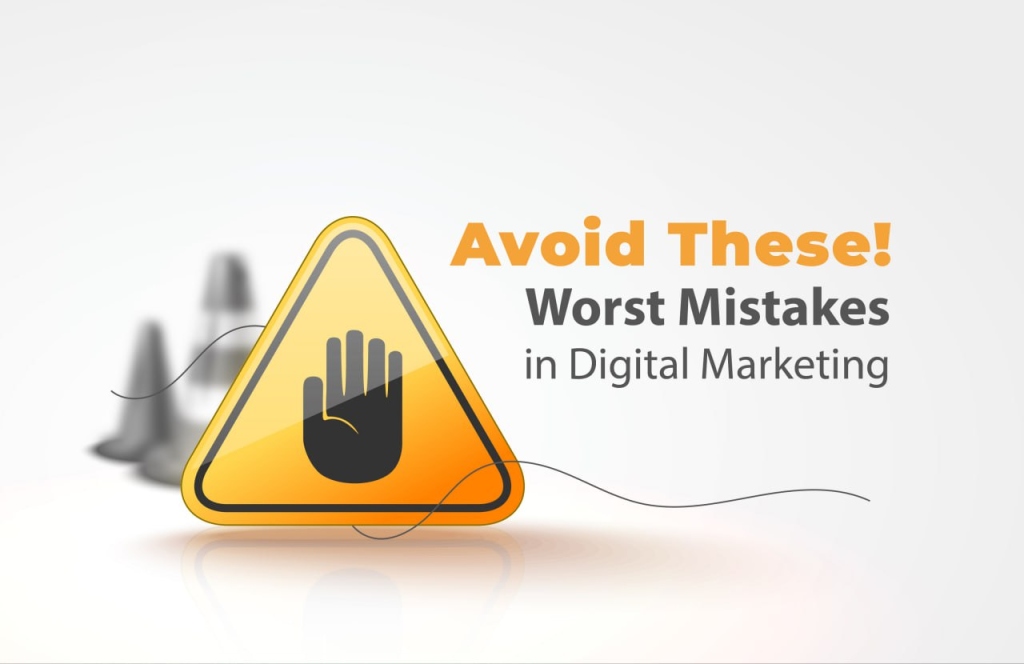
The internet has become an integral part of our daily lives and plays a crucial role for businesses, regardless of their size. Digital marketing is a vital tool for promoting your business, product, or service in various ways. However, it’s important to note that ineffective digital marketing can have detrimental effects on your product. Establishing an online presence can help you reach your target audience and build a positive reputation.
Nevertheless, it’s crucial to distinguish between proper and improper methods of conducting internet marketing. While online businesses can greatly benefit from digital marketing, some unfortunately experience setbacks.
One of the most common and significant mistakes is failing to understand the essence of digital marketing, leading to painful failures for businesses. There have been instances where brands suffered negative consequences due to digital marketing errors.
According to a report, global spending on digital marketing is projected to reach $146 billion by the end of 2023. This statistic highlights the willingness of businesses to invest in digital marketing strategies.
It is best to know what digital marketing mistakes to avoid. This article by Ravi from Cotocus PVT LTD presents the top digital marketing mistakes to avoid and how you can resolve them.
The Worst Digital Marketing Mistakes to Avoid

To address and overcome common digital marketing mistakes, you can follow these solutions:
- Lack of clear goals:
- Clearly define specific, measurable, attainable, relevant, and time-bound (SMART) goals for your digital marketing campaigns.
- Align your strategies and tactics with these goals.
- Regularly track and measure your progress towards achieving your goals.
2. Poor targeting:
- Conduct thorough market research to understand your target audience.
- Develop detailed buyer personas that include demographics, interests, and pain points.
- Tailor your marketing messages and channels to effectively reach and engage your target audience.
3. Ignoring mobile optimization:
- Optimize your website for mobile devices using responsive design.
- Ensure fast loading times and easy navigation on mobile devices.
- Test your website across different devices and screen sizes to ensure a seamless user experience.
4. Neglecting SEO:
- Conduct keyword research to identify relevant keywords for your industry.
- Optimize your website’s content, meta tags, headings, and URLs with targeted keywords.
- Build high-quality backlinks to improve your website’s authority and search engine rankings.
5. Lack of content strategy:
- Develop a comprehensive content strategy aligned with your target audience and business goals.
- Create an editorial calendar to plan and organize your content creation and distribution.
- Focus on providing valuable, informative, and engaging content that resonates with your audience.
6. Ineffective social media presence:
- Develop a solid social media strategy outlining your goals, target audience, content themes, and posting frequency.
- Engage with your audience by responding promptly to comments, messages, and mentions.
- Share relevant and engaging content, including images, videos, and articles, to build brand awareness and foster connections.
7. Neglecting data analysis:
- Use analytics tools like Google Analytics to track and measure campaign performance.
- Analyze key metrics such as website traffic, conversion rates, bounce rates, and engagement levels.
- Use data insights to optimize campaigns, make data-driven decisions, and identify areas for improvement.
8. Poor email marketing practices:
- Segment your email list based on demographics, interests, and behavior for targeted content delivery.
- Personalize email campaigns by addressing recipients by name and tailoring content to their needs.
- Monitor email engagement metrics like open rates and click-through rates, and adjust strategies accordingly.
9. Lack of A/B testing:
- Conduct A/B tests on various campaign elements like headlines, images, CTAs, and landing pages.
- Compare performance metrics to identify effective elements.
- Implement successful elements to improve conversion rates and overall performance.
10. Not adapting to changes:
- Stay updated with digital marketing trends, industry news, and emerging technologies.
- Continuously educate yourself through online resources, industry blogs, webinars, and conferences.
- Experiment with new strategies and techniques to adapt to changing consumer behaviors and preferences.
By implementing these solutions, you can address digital marketing mistakes, optimize your efforts, and achieve better results for your business.
Here are the best ways to do digital marketing and the mistakes to avoid.

To ensure originality, here are some recommendations for avoiding common mistakes in digital marketing:
- Define clear objectives: Establish specific, measurable, achievable, relevant, and time-bound (SMART) goals for your digital marketing campaigns. Clear objectives provide focus and help evaluate your progress accurately.
- Conduct thorough audience research: Gain a deep understanding of your target audience through comprehensive market research. Develop detailed buyer personas that encompass demographics, preferences, and pain points.
- Formulate a comprehensive digital marketing strategy: Create a well-defined strategy aligned with your goals and target audience. Outline the tactics, channels, and messaging you will employ to effectively reach and engage your audience.
- Prioritize mobile optimization: Given the prevalence of mobile device usage, prioritize optimizing your website, emails, and other digital assets for mobile devices. Ensure responsive design and seamless user experiences across various screen sizes.
- Implement effective SEO techniques: Enhance your website’s visibility in search engine results by conducting keyword research, optimizing meta tags, and creating high-quality, relevant content. Adhere to best practices for on-page and off-page SEO.
- Develop a robust content strategy: Craft a content strategy that caters to your target audience’s needs and interests. Plan and consistently produce valuable and relevant content across different channels to attract and engage your audience.
- Leverage data analytics: Regularly analyze data and metrics to gain insights into the performance of your digital marketing campaigns. Employ tools like Google Analytics to track website traffic, conversions, and user behavior, enabling data-driven decision-making.
- Foster audience engagement: Actively engage with your audience on social media platforms, promptly respond to comments and messages, and build authentic connections. Encourage dialogue and address customer queries and concerns proactively.
- Test and optimize campaigns: Continuously test different elements of your campaigns, such as ad creatives, landing pages, and email subject lines. Utilize A/B testing to identify the most effective variations and optimize your strategies accordingly.
- Stay updated and adaptable: Stay abreast of the latest trends, technologies, and shifts in the digital marketing landscape. Attend industry events, follow reputable blogs, and engage in continuous learning to remain ahead of the curve.
- Seek professional guidance: Consider collaborating with experienced digital marketing professionals or agencies who can offer expertise and guidance tailored to your specific needs.
By following these guidelines, you can mitigate the risk of mistakes and optimize your digital marketing endeavors for enhanced outcomes and returns on investment.
Thanks,






Leave a Reply
You must be logged in to post a comment.